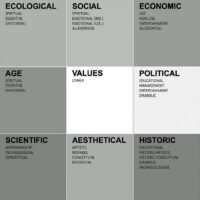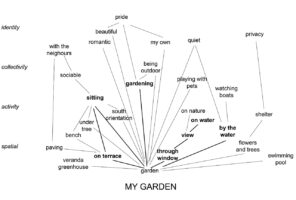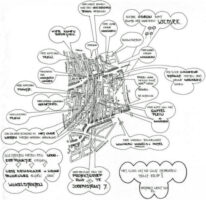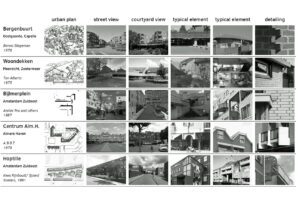Not Everything is Heritage – Everything is Legacy
Published on: website Architectenweb, 2024
 On 13 December, Lidwine Spoormans received her PhD from TU Delft for her thesis Everyday Heritage, Identifying attributes of 1965-1985 residential neighbourhoods by involved stakeholders. Her central thesis was: ‘Everything is heritage, so nothing is heritage’. This echoes activism, which Spoormans was subjected to stern questions from the scientific review committee. She paraphrased Virginia Woolf’s famous quote: ‘A part-time PhD candidate needs money, a history and a room of one’s own’. I decided to write down my fascination, by way of a preface that is omitted from academic publications and hopefully contributes to understanding the genesis of this thesis.
On 13 December, Lidwine Spoormans received her PhD from TU Delft for her thesis Everyday Heritage, Identifying attributes of 1965-1985 residential neighbourhoods by involved stakeholders. Her central thesis was: ‘Everything is heritage, so nothing is heritage’. This echoes activism, which Spoormans was subjected to stern questions from the scientific review committee. She paraphrased Virginia Woolf’s famous quote: ‘A part-time PhD candidate needs money, a history and a room of one’s own’. I decided to write down my fascination, by way of a preface that is omitted from academic publications and hopefully contributes to understanding the genesis of this thesis.
Between 2003 and 2011, Spoormans worked at the architecture firm biq stadsontwerp where I was director together with Rick Wessels. That period roughly coincides with the design and implementation period of the renovation of 704 post-war splayed apartments blocks in Rotterdam Ommoord and the publication of the book Architecture in the Broken City, which attempted to rationally formulate this kind of design task.

At the time, Rick and I were more interested in ‘the ugly and the ordinary’ of American architects Robert Venturi and Denise Scott Brown than with the solemn heritage discussions about the postwar urbanism. We discussed multiple issues: investments, financial returns, maintenance and implementation problems, as well as local histories. Pim Fortuyn had just been assassinated. Ommoord was one of the bakermats of the Rotterdam populist movement. Conversations would start with concrete incidents, for instance complaints about new tenants who dared to park their bikes on the gallery. This went against the unwritten codes in the flat community that had been fairly homogeneous for 30 years. Those same conversations could transition seamlessly into the down-to-earth conclusion that things just change and that here was in fact ordinary urbanisation, with diverse newcomers taking the place of the pioneer generation.
From the mishmash of observations, opinions and goals, we tried to distil a rational task definition for design. However, an interest in the ugly and ordinary does not suddenly make an architect responsible for anything and everything. Rick and I were wary of ‘scope creep’ and the tendency for briefs to expand until they are about everything and therefore about nothing. We demarcated our firm’s input from the things that fell outside our mandate and expertise as building designers.

Lidwine Spoormans worked on the Ommoord project and developed into a critical fellow traveller. After leaving, she started her own architectural firm, became involved in teaching at TU Delft, wrote the publication Koppen, het aanzien van de kopgevel in de afgelopen 125 jaar with Marjolein van Eig and began work on her dissertation.
It is precisely in the disentanglement of observations, opinions and goals that she has made strides in heritage discussions. Spoormans uses several methods to organise that mishmash. She does so by ordering attributes (the physical and non-physical things in spatial heritage) at different spatial scales. She distinguishes between them and shows how different stakeholders (residents, visitors, local professionals, administrators, academics, creators and owners) view them.

On the one hand, this is a completely quantitative exercise. It turns out, for instance, that professionals tend to limit themselves to their own domain, while for residents all kinds of different aspects are important. The same applies to stakeholders with a mixed profile, such as designers who are also residents or administrators who are also academics. On the other hand, this is a matter of interpretation. For instance, Spoormans uses web diagrams to visualise how the tangible attribute ‘garden’ is linked to the activity ‘sitting’ and ultimately relates to notions of community, romanticism, beauty and pride. Almere Haven residents appear to be aware of the ordinariness of their living environment compared to cities like Amsterdam. They effortlessly link that awareness to the holiday feeling evoked by nature around the corner. Spoormans’ findings reveal a stable habitat – a fact of importance in the sustainability era.

Spoormans employs a multiple definition of the attributes of the ugly and the ordinary. She transcends those street interviews that are sometimes simplified in urban renewal into cartoons in which all the problems are ascribed the same magnitude. In the text balloons, respondents’ opinions range from the inevitable trivialities about dog dirt, litter and leaky windows to serious concerns about affordability and the lack of social cohesion. You can take residents seriously without granting them the natural rightness of experiental expertise.

City renewal benefits from finding simple answers to complex questions. This is different from simplifying the questions themselves. In practice, unfortunately, the task definition is often an optional event, in which stakeholders are served in an ad hoc manner and decision-makers switch effortlessly between the various questions at hand. For instance, the sustainability theme would appear dominant in design practice, but is rarely a topic linked to concrete benefits for stakeholders in the existing city. It is a theme that easily falls out of the picture in the face of budgetary headwinds. In short, the progressive world of ideas and the concrete perceptions of stakeholders become disconnected. Sentiment about that failure is manifesting itself more and more clearly, not only in the latest election results.

Whether or not everything falls under the heading of heritage, Spoormans concludes that housing construction between 1965 and 1985 should be treated with caution. She argues for a more equal and reciprocal relationship between citizens and government and for the democratic renewal of heritage processes.
Everything is heritage, so nothing is heritage. Lidwine Spoormans’ activism is a timely one. It seems to me that there is opportunity to sharpen that statement. Not everything is heritage – everything is legacy. The status of heritage can hardly be disputed. A legacy has to be divided and that guarantees spirited discussions.